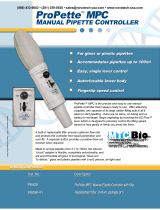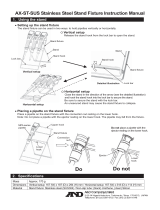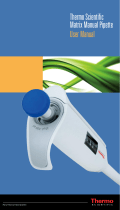13
11 MAINTENANCE
Routine maintenance will help keep your pipette in
good condition, ensuring a continued high level of
performance. Maintenance is limited to cleaning or
autoclaving the parts specified under Chapter 12 -
Cleaning and Decontamination or to replacing the
push-button, connecting nut, tip-ejector, tip-holder,
seal and O-ring.
PIPETMAN P2 and P10 should not be disassembled,
so you may only replace the push-button, tip-ejector,
dual position tip-ejector and its adapter. With these
pipettes if the tip-holder is damaged, the piston may
also be damaged.
After replacing any parts you should
verify the performance of your pipette
following the verification procedure
available on the Gilson website (www.
gilson.com). If the pipette needs to be
readjusted, please contact your local
Gilson authorized Service Center.
Changing the Tip-ejector
To remove the tip-ejector, keep the tip-ejector
button depressed and pull down on the flanged
upper part of the tip-ejector with the other hand.
To refit the tip-ejector, keep the tip-ejector button
depressed, slide the end of the tip-ejector over
the end of the tip-holder and push the plastic
end of the tip-ejector back into the body of the
pipette until it is gripped firmly by the metal
tip-ejector rod.
Changing the Tip-holder – no tools required
Remove the tip-ejector (see above).
Unscrew the connecting nut by turning it counter-
clockwise.
Carefully separate the lower and upper parts.
























